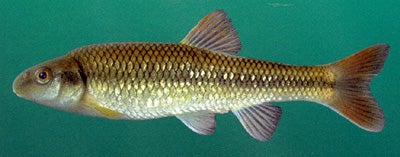BLUEHEAD CHUB
SCIENTIFIC NAME: Nocomis leptocephalus
CHARACTERISTICS: The bluehead chub is a stout, short, relatively deep-bodied species. Fewer head tubercles on males—typically no more than 25 (Lachner and Jenkins, 1971)—distinguish this from other Nocomis species. The snout is short, the head generally large, and the mouth horizontal. Breeding males develop prominently swelled heads (a condition known as nuptial crests), which are typically blue on the sides. The lateral stripe is light tan to orange. The fins, all of which have rounded contours, are orange or red.
ADULT SIZE: 2.8 to 6.7 in (70 to 170 mm)
DISTRIBUTION: The bluehead chub is found in Atlantic slope drainages from the lower Chesapeake basin south to the Altamaha River drainage in Georgia. It occurs primarily above the Fall Line in the Apalachicola basin. Nocomis leptocephalus is found extensively in the Mobile basin below the Fall Line, with a sharp southern demarcation along the lower edge of the Lime Hills physiographic district. This species is notably absent from the Black Belt but occurs extensively above the Fall Line in the Tallapoosa River system; only a few localities are known in the upper Coosa River. Individuals are also known from the Escambia basin in extreme south Alabama and from the Halawakee Creek system in the Chattahoochee River drainage. The bluehead chub has also invaded the Tennessee River drainage in the Bear Creek system.
HABITAT AND BIOLOGY: Species of Nocomis generally prefer clear streams of small to moderate size with moderate to high gradient. A substrate of gravel or small stones is usually required, because these materials are used for building nests that will protect fertilized eggs. Usually dome-shaped and sometimes containing up to 10,000 stones, nests are constructed from April to June (Lachner, 1952), with spawning occurring from late spring to midsummer. Lachner reports longevity of more than four years. Several species in Alabama are known to spawn in conjunction with Nocomis nests, including the largescale stoneroller, Campostoma oligolepis; striped shiner, Luxilus chrysocephalus; rosefin shiner, Lythrurus ardens; rainbow shiner, Notropis chrosomus; rosyface shiner, N. rubellus; southern redbelly dace, Phoxinus erythrogaster; and blackside darter, Percina maculata.
ORIGINAL DESCRIPTION: Girard described the bluehead chub in 1856.
ETYMOLOGY:
Nocomis is in reference to Longfellow’s Song of Hiawatha, name meaning “daughter of the moon."
Leptocephalus means slender head.
The copyrighted information above is from Fishes of Alabama and the Mobile Basin.






